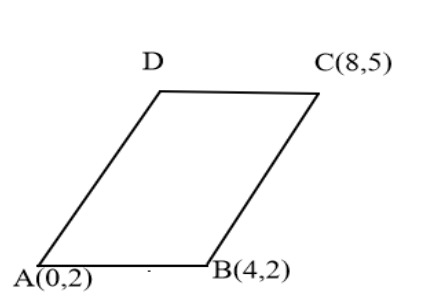
In the figure, ABCD is a parallelogram.
a) Write the coordinates of D.
b) What is the height of this parallelogram?
c) Find the perimeter and area of it.


Answer
604.5k+ views
Hint: Here we will find the coordinates of D, height, perimeter and area of the parallelogram by considering the geometry concepts and properties of parallelogram.
Complete step-by-step answer:
a) Coordinates of D
Distance between A and B
$ \Rightarrow \sqrt {{{(4 - 0)}^2} + {{(2 - 2)}^2}} = \sqrt {16} = 4$
Since the opposite sides of a parallelogram are equal, the distance between C and D is also 4. Also, the y-coordinates of A and B are equal, the sides AB is parallel to the x-axis. And since ABCD is a parallelogram, CD is also parallel to the x-axis. So the y-coordinates of C and D are also equal.
Thus, the x-coordinate of $D = 8 - 4 = 4$
Hence, the coordinates of ’D’ are (4, 5).
b) Height of the parallelogram
The x-coordinates of D and B are equal. So the line BD is parallel to the y-axis or BD is perpendicular to the x-axis.
So, height of the parallelogram $ = DB = \left| {{y_1} - {y_2}} \right| = \left| {5 - 2} \right| = 3$
c) Perimeter and area of the parallelogram
Find the distance between B and C
$
BC = \sqrt {{{({x_2} - {x_1})}^2} + {{({y_2} - {y_1})}^2}} \\
BC = \sqrt {{{(8 - 4)}^2} + {{(5 - 2)}^2}} \\
BC = \sqrt {{{(4)}^2} + {{(3)}^2}} \\
BC = \sqrt {16 + 9} \\
BC = \sqrt {25} = 5 \\
$
$AD = BC = 5{\text{ units}}$
Perimeter=$2(4 + 5) = 2 \times 9 = 18$units.
Area=Base x Height
Area$ = 4 \times 3 = 12$ sq .units
Note: In this type of question we have to apply the relationship between the parallel line and perpendicular line and use the various formulas like distance formula to arrive at the solution.
Complete step-by-step answer:
a) Coordinates of D
Distance between A and B
$ \Rightarrow \sqrt {{{(4 - 0)}^2} + {{(2 - 2)}^2}} = \sqrt {16} = 4$
Since the opposite sides of a parallelogram are equal, the distance between C and D is also 4. Also, the y-coordinates of A and B are equal, the sides AB is parallel to the x-axis. And since ABCD is a parallelogram, CD is also parallel to the x-axis. So the y-coordinates of C and D are also equal.
Thus, the x-coordinate of $D = 8 - 4 = 4$
Hence, the coordinates of ’D’ are (4, 5).
b) Height of the parallelogram
The x-coordinates of D and B are equal. So the line BD is parallel to the y-axis or BD is perpendicular to the x-axis.
So, height of the parallelogram $ = DB = \left| {{y_1} - {y_2}} \right| = \left| {5 - 2} \right| = 3$
c) Perimeter and area of the parallelogram
Find the distance between B and C
$
BC = \sqrt {{{({x_2} - {x_1})}^2} + {{({y_2} - {y_1})}^2}} \\
BC = \sqrt {{{(8 - 4)}^2} + {{(5 - 2)}^2}} \\
BC = \sqrt {{{(4)}^2} + {{(3)}^2}} \\
BC = \sqrt {16 + 9} \\
BC = \sqrt {25} = 5 \\
$
$AD = BC = 5{\text{ units}}$
Perimeter=$2(4 + 5) = 2 \times 9 = 18$units.
Area=Base x Height
Area$ = 4 \times 3 = 12$ sq .units
Note: In this type of question we have to apply the relationship between the parallel line and perpendicular line and use the various formulas like distance formula to arrive at the solution.
Recently Updated Pages
Master Class 10 General Knowledge: Engaging Questions & Answers for Success

Master Class 10 Computer Science: Engaging Questions & Answers for Success

Master Class 10 English: Engaging Questions & Answers for Success

Master Class 10 Social Science: Engaging Questions & Answers for Success

Master Class 10 Maths: Engaging Questions & Answers for Success

Master Class 10 Science: Engaging Questions & Answers for Success

Trending doubts
The shortest day of the year in India

Why is there a time difference of about 5 hours between class 10 social science CBSE

Write a letter to the principal requesting him to grant class 10 english CBSE

What is the median of the first 10 natural numbers class 10 maths CBSE

The Equation xxx + 2 is Satisfied when x is Equal to Class 10 Maths

State and prove converse of BPT Basic Proportionality class 10 maths CBSE




